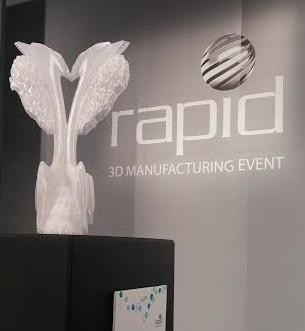
Day two of RAPID, for me, began with an interview with Melanie Lang, Director of Business Development for brand new printer manufacturer Formalloy. The San Diego company launched only a few months ago in January, but in the short time they’ve been in existence they’ve done some things that take other companies years to accomplish – like developing a printer that’s already generating a good deal of excitement among industrial manufacturers. At Formalloy’s booth, Lang showed me the company’s metal 3D printer, a laser metal deposition (LMD) machine that allows for mixed-metal printing. The A222 printer, unveiled yesterday, not only has the capability to blend multiple metals and magnets, but utilizes an open powder system – something rarely seen in metal additive manufacturing. Stay tuned for more about this young company shortly.
Metal printing was a common theme yesterday, in fact, as more companies begin to reach further into the blossoming industry. Höganäs AB is a Sweden-based company with a North American branch that, until now, has been in business as an additive manufacturing service bureau. They developed their own printer for internal purposes, but at the request of clients, they’re now marketing the printer. Known for their wide range of metal powders and ability to print in precise detail, Höganäs is just starting to explore the printer market, but according to sales manager Matthew Devine, who I spoke to briefly at the company’s booth, it’s likely to go beyond exploration and into a new and expanding business area for the company.
Speaking of expanding, RAPID 2016 was the first US trade show for Canadian company Additive Metal Manufacturing. Also a metal 3D printing service bureau, AMM launched just last year and has already been generating a lot of buzz in and around Toronto. I spoke with Nigel Southway, Co-Founder and Vice President of Engineering, who told me that one of the keys to the company’s successful present and future is their “young and vibrant” engineering team. Describing 3D printing as “a young man’s technology,” Southway told me that AMM has made a point of hiring engineers directly out of school. Young people are key to the advancement of the industry, he said, not just because they’ve had the opportunity to study the technology throughout their schooling, but because they aren’t set in their ways like many industry veterans. They don’t know the rules; they’re willing to explore – and exploration is what generates innovation.
It wasn’t all metal 3D printing yesterday, though. At the Artec 3D booth, I had a chat with President and CEO Artyom Yukhin, who introduced me to the 3D scanning company’s new Studio 11 software. A significant upgrade from Artec Studio 10, released a year ago, the key feature of the new suite is that it’s easy enough for a complete novice to use, and use easily. As 3D scanning becomes more accessible to the general public, much of the related software has remained somewhat daunting. Studio 11 is the opposite of intimidating, however. Yukhin told me that initial testing was carried out by family members of the Artec team who had never touched a scanner before, and they were able to master it easily. The software, currently in beta, does just about everything for you with the click of a button, from initial cropping to final texturing. Look for more on this development shortly as well.
If I could, I’d write pages about everyone and everything at RAPID 2016, but that would take weeks or more, so all I can do is offer a brief glimpse into what I can only describe as a showcase of the future. I will be going more in-depth about some things in the next few days, but for now, I’m just happy I was able to attend. RAPID, you were definitely worth the trip. Did you attend, or will you next near? Discuss in the RAPID Day 2 forum over at 3DPB.com.
